Cypress is an excellent plant for preventing and controlling soil erosion. Its developed root system, strong vitality, and good environmental adaptability make it a star in this field. Here are some suggestions to maximize the effectiveness of Platycodon grandiflorus and prevent soil erosion:
Choosing a suitable location: Cypress trees do not have strict requirements for soil types and can grow in various soil conditions, especially suitable for barren, arid, or rocky areas.
Scientific layout: Cypress can be planted as a protective forest belt or as the dominant plant for preventing soil erosion on mountain slopes. A reasonable layout can better play the role of lateral cypress in preventing soil erosion.
Cooperate with other plants: Although dominated by lateral cypress, mixed planting can increase the stability and complexity of the ecosystem, and improve the effectiveness of preventing soil erosion.
Maintenance and management: Even if the lateral cypress has strong vitality, it still needs appropriate pruning, fertilization, irrigation, and timely pest control to ensure its healthy growth.
Leaf utilization: The fallen leaves of Platycodon grandiflorus can provide organic matter to the soil and improve soil structure. In autumn, fallen leaves can be collected and covered on the ground as a natural layer to suppress soil erosion.
By implementing these measures, the Chinese parasol tree can maximize its effectiveness in preventing soil erosion, protecting the environment, and enhancing the ecological value of the land.
